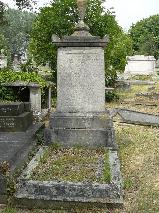Ainsworth, William Harrison |
| NOVELIST (ENGLAND) |
|
BORN 4 Feb 1805, Manchester: 21 King Street - DIED 3 Jan 1882, Reigate, Surrey GRAVE LOCATION London: Kensal Green Cemetery, Harrow Road, Kensal Green (154/PS (3443)) |
|
Son of a Thomas Ainsworth, a lawyer in Manchester. He was trained as a lawyer himself but he wasn't interested in a legal career and by 1821 he was publishing articles in magazines. He corresponded with Charles Lamb who reacted favourably to some of his poems. In 1824 his father died and he became a senior partner in the law firm. He went to London to study under barrister Jacob Phillip. Lamb was a disappointment to him when he visited him in London, but he met people around him like Henry Crabb Robinson and Mary Shelley. He befriended the publisher John Ebers and he married his daughter Fanny in 1826. In 1826 his novel "Sir John Chiverton" was published and in 1828 he met Sir Walter Scott. Adviced by Ebbers he sold his stake in the law firm and invested in the publishing business. Initially things went well, but Ebbers went bankrupt and Aintworth lost much of his money. In 1829 he was doing research for a novel, "Rookwood" and he was living at Kensal Lodge. Together with his friend William Sergison he travelled to Switzerland and Italy, where they visited the tombs of Keats and Shelley. His financial situation worsened because he had three children now and his father in law was still in financial trouble. But in 1834 "Rookwood" about Dick Turpion was published and it was an instant success. He moved in literary circles now and between 1835 and 1838 he often travelled with Charles Dickens. He was also visited by Thackeray at Kensal Lodge. His 'Newgate novel' "Jack Sheppard" (1839) caused a controversy that damaged his friendship with Dickens although they were still in contact during the 1840s. In 1842 he started "Ainsworth's Magazine" with George Cruikshank as its illustrator. During the same year "The Miser's Daughter" was published. In 1845 he left the magazine after a fight with the new owner John Mortimer and he started "The New Monthly Magazine" but soon he was again in charge of "Ainsworth's Magazine" and he edited it until it ceased to appear in 1854. In that year he bought "Bentley's Miscellany" and he edited this magazine as well until he sold it in 1868. During the 1850s he moved from London to Brighton. His work required him to travel by train to London often. In 1867 he moved to Tunbridge Wells, Kent. In 1872 he quarreled with Cruikshank over a theatre version of "The Miser's Daughter". Cruikshank was angry that his name had been left out of the credits and claimed that the idea for the novel had been his. A controversy followed. In 1878 he married for the second time. During his life he published forty historical romances. He died in 1882 and was buried at Kensal Green Cemetery, not far from Kensal Lodge. His reputation didn't last very long and little was written about him after his death. Related persons • was a friend of Dickens, Charles • visited Lamb, Charles • was painted by Maclise, Daniel • has a connection with Ouida • met Robinson, Henry Crabb • met Shelley, Mary • knew Thackeray, William Makepeace |
| Images |
Sources • Paths of Glory, The Friends of Kensal Green Cemetery, London, 1997 • William Harrison Ainsworth - Wikipedia (EN) • William Harrison Ainsworth (1805-1882) — King of the Historical Potboiler: A Brief Biography |



